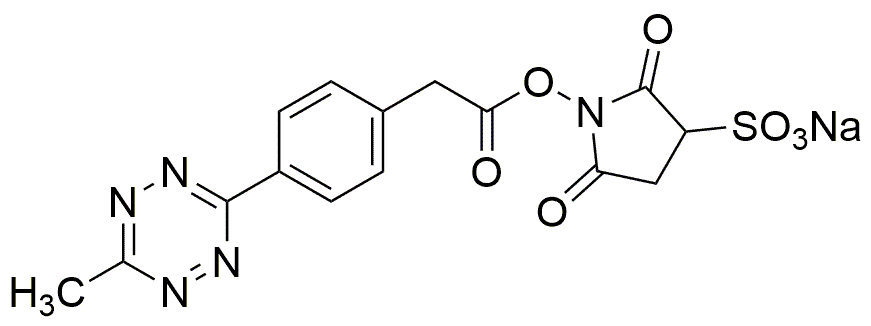Methyltetrazine-Sulfo-NHS ester is widely utilized in research focused on:
- Bioconjugation: This compound is commonly used to attach biomolecules, such as proteins or antibodies, to surfaces or other molecules, enhancing the development of targeted therapies and diagnostics.
- Fluorescent Labeling: It serves as a linker for fluorescent dyes, allowing researchers to visualize cellular processes in real-time, which is crucial in cell biology and drug discovery.
- Drug Development: The ester form facilitates the modification of drug candidates, improving their pharmacokinetic properties and bioavailability, which is essential in pharmaceutical research.
- Diagnostics: Used in the creation of assays for detecting specific biomolecules, this compound plays a vital role in developing sensitive diagnostic tools for various diseases.
- Research in Neuroscience: It is employed in the study of neurochemical pathways, helping scientists understand brain functions and disorders, thus contributing to advancements in neuropharmacology.
Informations générales
Propriétés
Sécurité et réglementation
Applications
Methyltetrazine-Sulfo-NHS ester is widely utilized in research focused on:
- Bioconjugation: This compound is commonly used to attach biomolecules, such as proteins or antibodies, to surfaces or other molecules, enhancing the development of targeted therapies and diagnostics.
- Fluorescent Labeling: It serves as a linker for fluorescent dyes, allowing researchers to visualize cellular processes in real-time, which is crucial in cell biology and drug discovery.
- Drug Development: The ester form facilitates the modification of drug candidates, improving their pharmacokinetic properties and bioavailability, which is essential in pharmaceutical research.
- Diagnostics: Used in the creation of assays for detecting specific biomolecules, this compound plays a vital role in developing sensitive diagnostic tools for various diseases.
- Research in Neuroscience: It is employed in the study of neurochemical pathways, helping scientists understand brain functions and disorders, thus contributing to advancements in neuropharmacology.
Documents
Fiches de données de sécurité (FDS)
La FDS fournit des informations de sécurité complètes sur la manipulation, le stockage et l’élimination du produit.
Spécifications du produit (PS)
Le PS fournit une description complète des propriétés du produit, notamment sa composition chimique, son état physique, sa pureté et les exigences de stockage. Il détaille également les plages de qualité acceptables et les applications prévues du produit.
Certificats d'analyse (COA)
Recherchez des certificats d'analyse (COA) en saisissant le numéro de lot du produit. Les numéros de lot et de lot se trouvent sur l'étiquette d'un produit, après les mots « Lot » ou « Lot de fabrication ».
Numéro de catalogue
Numéro de lot/série
Certificats d'origine (COO)
Ce certificat d'exploitation confirme le pays dans lequel le produit a été fabriqué, et détaille également les matériaux et composants utilisés et s'il est issu de sources naturelles, synthétiques ou autres sources spécifiques. Ce certificat peut être requis pour les douanes, le commerce et la conformité réglementaire.
Numéro de catalogue
Numéro de lot/série
Fiches de données de sécurité (FDS)
La FDS fournit des informations de sécurité complètes sur la manipulation, le stockage et l’élimination du produit.
DownloadSpécifications du produit (PS)
Le PS fournit une description complète des propriétés du produit, notamment sa composition chimique, son état physique, sa pureté et les exigences de stockage. Il détaille également les plages de qualité acceptables et les applications prévues du produit.
DownloadCertificats d'analyse (COA)
Recherchez des certificats d'analyse (COA) en saisissant le numéro de lot du produit. Les numéros de lot et de lot se trouvent sur l'étiquette d'un produit, après les mots « Lot » ou « Lot de fabrication ».
Numéro de catalogue
Numéro de lot/série
Certificats d'origine (COO)
Ce certificat d'exploitation confirme le pays dans lequel le produit a été fabriqué, et détaille également les matériaux et composants utilisés et s'il est issu de sources naturelles, synthétiques ou autres sources spécifiques. Ce certificat peut être requis pour les douanes, le commerce et la conformité réglementaire.

